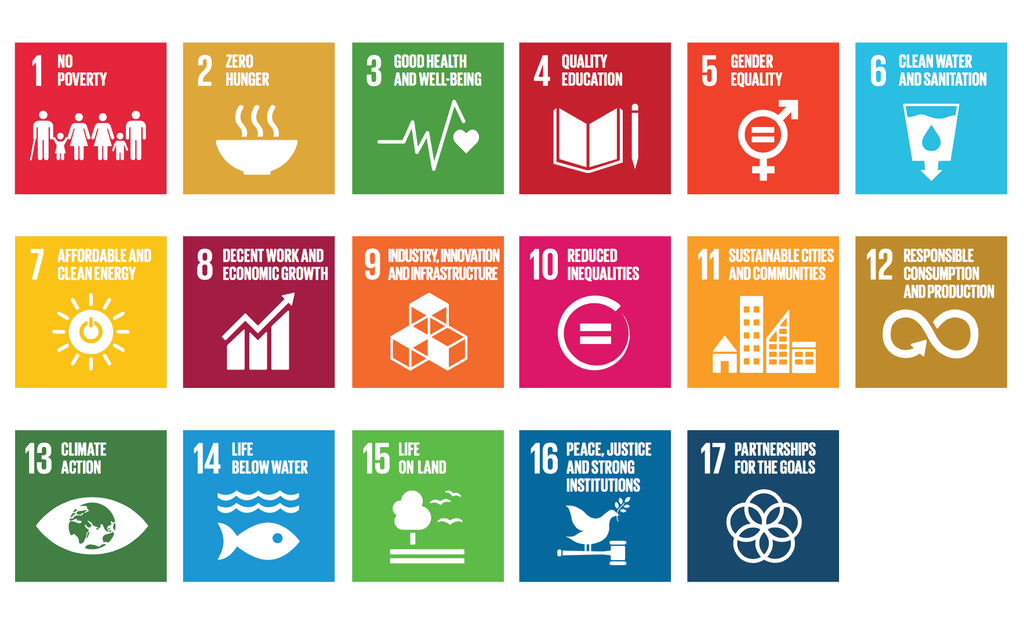How does fashion affect the SDGs?
The 2030 Agenda for Sustainable Development was adopted by all United Nations Member States in 2015, and at its heart are the 17 Sustainable Development Goals (SDGs). The SDGs are an urgent call for action by all countries, “recognizing that ending poverty and other deprivations must go hand-in-hand with strategies that improve health and education, reduce inequality, and spur economic growth – all while tackling climate change and working to preserve our oceans and forests (UN website).”
Learn how the fashion industry can be part of solutions for almost every single SDG!

I know this might seem like a dry topic—and one that probably makes you feel more like you're in a lecture hall. But I promise this will be MUCH more exciting!
I love the SDGs because they give such a good and comprehensive framework to think about any industry and any company in the context of doing good in the world. And it is broad enough that companies and NGOs can choose key focus areas, all while contributing to the overall goals set by the United Nations 193 member states back in 2015.
What's so interesting about fashion is that it really does have the potential to impact all 17 SDGs (some more than others, for sure). So I've done some thinking and exploring and I've listed below how I see fashion being part of the solution for each goal.
1. No Poverty: End poverty in all its forms everywhere
Fashion is one of the world's largest industry, valued at over $3 trillion. Yet, an estimated 98% of fashion workers do not make a living wage. That means 98% of workers are being held in poverty because of the practices of our industry.
If the fashion industry put a concerted effort to move towards living wages, there would be massive effects on global poverty.
2. Zero Hunger: End hunger, achieve food security and improved nutrition and promote sustainable agriculture
This one isn't as relevant to the fashion industry as others, but hunger and poverty do go hand-in-hand. This SDG speaks more to agriculture and small-scale farming, but we also know that fashion is dependent on agriculture because of the raw materials used. So when we improve the standards of our industry, there's a ripple effect to others, and vice versa. Also, when people are paid living wages and are able to provide for their families, they are able to invest in improved nutrition.
3. Good Health and Wellbeing: Ensure healthy lives and promote well-being for all at all ages
On the UN's website for Goal #3, it says the following: "However, progress has stalled or is not happening fast enough with regard to addressing major diseases, such as malaria and tuberculosis, while at least half the global population does not have access to essential health services and many of those who do suffer undue financial hardship, potentially pushing them into extreme poverty."
The ability to access and afford essential health services is not a luxury for so many people. And the people who have the least access to these services are often the ones who are already marginalized, living in poverty, and in the least secure jobs. The fashion industry is a prominent industry in many countries that lack this access, and it has a role to play.
4. Quality Education: Ensure inclusive and equitable quality education and promote lifelong learning opportunities for all
A lot of children stop going to school because they have to go to work. When we bring people to living wages and help lift families out of poverty, they are able to invest in their children's education.
5. Gender Equality: Achieve gender equality and empower all women and girls
75% of fashions 60+ million workers are women. It is one of the largest employers of women worldwide, which means that in order to achieve gender equality globally, fashion MUST be an active driver of solutions.
6. Clean Water and Sanitation: Ensure availability and sustainable management of water and sanitation for all
Despite progress, billions of people still lack safe water, sanitation and handwashing facilities. The role that fashion can play in this SDG is in curbing its negative environmental impact. The chemicals used in fashion manufacturing end up contaminating water sources and creating more of a problem in accessing clean water.
7. Affordable and Clean Energy: Ensure access to affordable, reliable, sustainable and modern energy for all
This one is admittedly a stretch... Fashion doesn't play that big of a role in the systemic issue or the solutions to this SDG, but it can participate and play its part by prioritizing clean energy in its manufacturing operations.
8. Decent Work and Economic Growth: Promote sustained, inclusive and sustainable economic growth, full and productive employment and decent work for all
Now this one is definitely NOT a stretch. Fashion employs millions of people worldwide and is part of basically every single country's economy. We can contribute to this goal by actively hiring women and other economically marginalized groups and by paying living wages (which is a human right, by the way), which is a crucial component of decent work.
9. Industry, Innovation, and Infrastructure: Build resilient infrastructure, promote inclusive and sustainable industrialization and foster innovation
The fashion industry's largest countries of operation are typically under-developed countries that are in need of more resilient infrastructure and sustainable industrialization. Because the fashion industry is such a large economic drive in these areas, they have an opportunity to lead the way in these efforts, rather than contributing to problem.
10. Reduced Inequalities: Reduce inequality within and among countries
One of the targets for this SDG (10.4) is to "Adopt policies, especially fiscal, wage and social protection policies, and progressively achieve greater equality." While this SDG has more of a focus on policy and country-wide systemic change, key industries, especially ones as big as the global fashion industry, can be a powerful force in moving the needle on this.
11. Sustainable Cities and Communities: Make cities and human settlements inclusive, safe, resilient and sustainable
This SDG is focused on a number of aspects of city-life, including access to affordable housing and transportation. A lot of the fashion manufacturing happens in urban areas, so this certainly affects fashion workers.
12. Responsible Consumption and Production: Ensure sustainable consumption and production patterns
Now, this is VERY tied to fashion. With the emergence of fast fashion, consumption has skyrocketed, leading to increased human rights and environmental abuses as a result. I'm copying what the UN has to say about it, because I couldn't have written it better...
"Worldwide material consumption has expanded rapidly, as has material footprint per capita, seriously jeopardizing the achievement of Sustainable Development Goal 12 and the Goals more broadly. Urgent action is needed to ensure that current material needs do not lead to the over-extraction of resources or to the degradation of environmental resources, and should include policies that improve resource efficiency, reduce waste and mainstream sustainability practices across all sectors of the economy."
13. Climate Action: Take urgent action to combat climate change and its impacts*
The fashion industry at large has a negative impact on the environment, and its impact contributes to climate change. But it also has an opportunity to participate in positive change by actively increasing its circularity principles and reducing its water and natural resources consumption.
14. Life Below Water
The fashion industry is a big polluter of water due to the chemicals used in manufacturing that are disposed of in waterways. More than a half trillion gallons of fresh water are used in the dyeing process of textiles each year, amounting to 20% of global industrial water pollution. This harms life below water, so efforts to curb fashion's pollution will help contribute to SDG 14.
15. Life on Land: Protect, restore and promote sustainable use of terrestrial ecosystems, sustainably manage forests, combat desertification, and halt and reverse land degradation and halt biodiversity loss
This one isn't quite as relevant, but there's a lot of aspects of fashion that do affect animals. For example, leather is an animal byproduct, and we have to be intentional about responsible sourcing. For example, cattle ranching is a big cause of deforestation, but at the same time, it is an essential part of so many countries' economic systems. It's not all bad, but you have to be careful. It's something we are very conscious with at ABLE.
16. Peace, Justice, and Strong Institutions: Promote peaceful and inclusive societies for sustainable development, provide access to justice for all and build effective, accountable and inclusive institutions at all levels
One of the targets for SDG 16 is about eliminating trafficking and abuse of all kinds, and the global fashion industry unfortunately has a lot of forced/trafficked labor. It's also about accountability and transparency, which we need.
17. Partnerships for the Goals
This one is pretty obvious, but for these goals to be a reality, it cannot just be up to governments or NGOs. Industries and consumers are just as important, and absolutely crucial to












Comments
Ngwi said:
Thank u